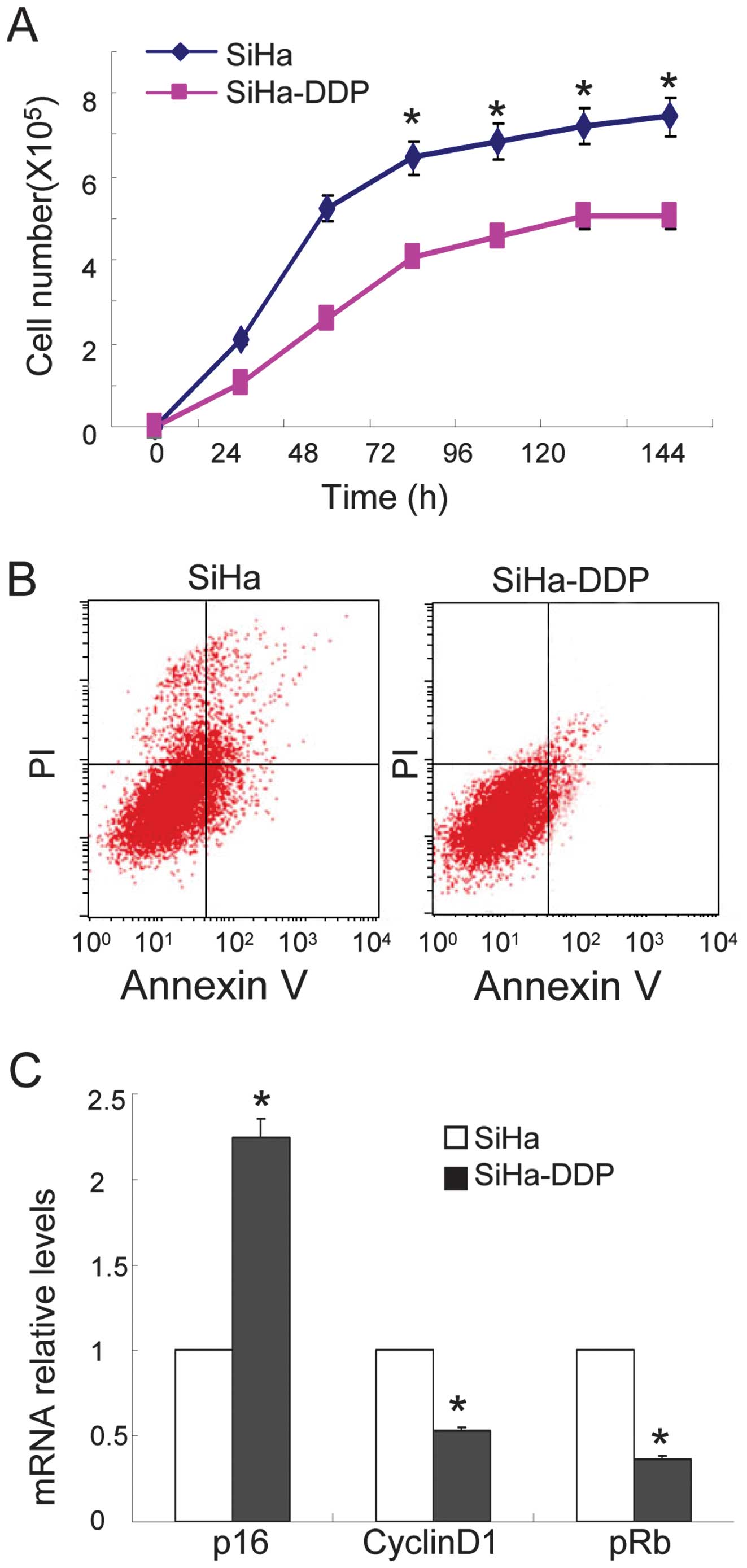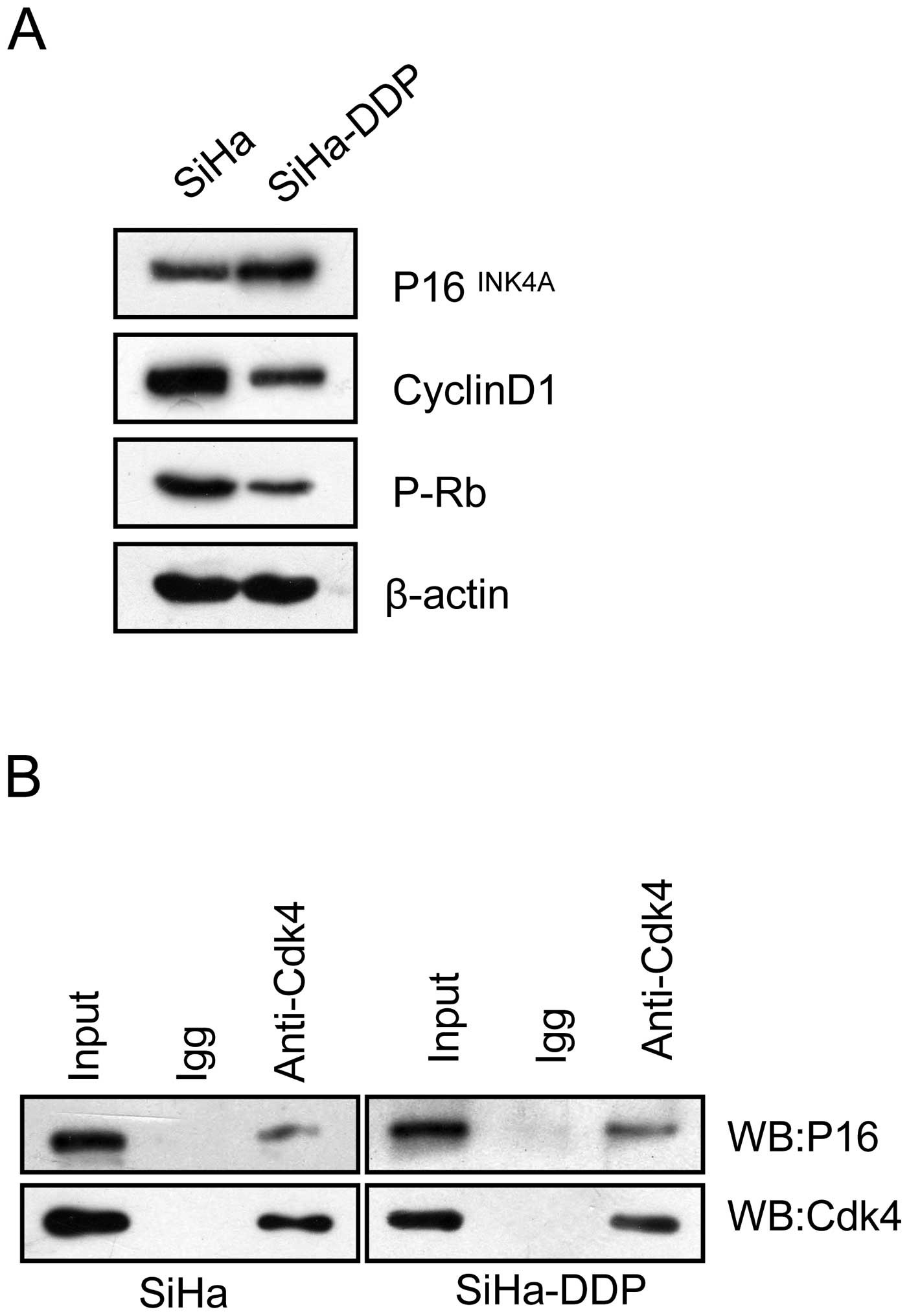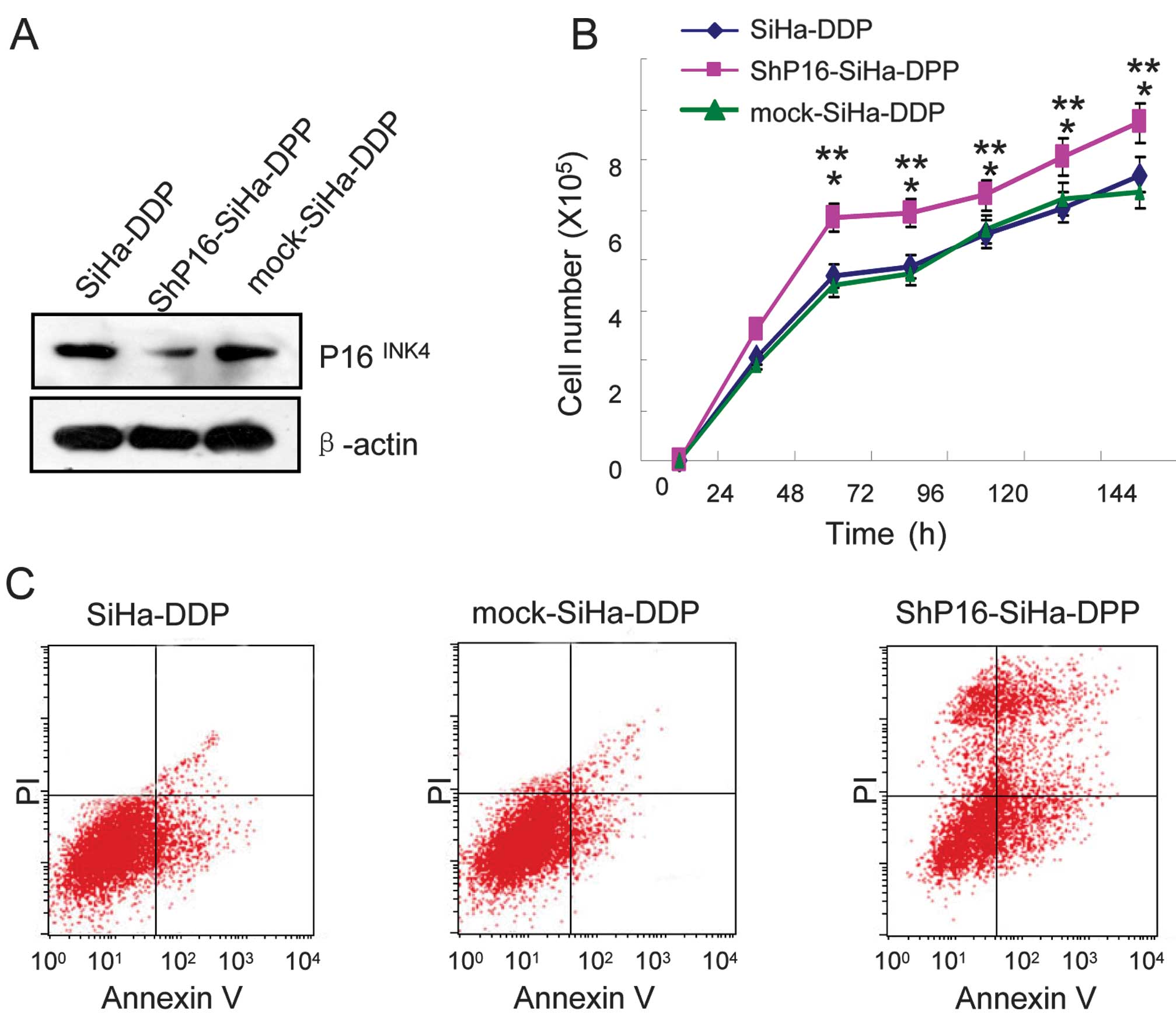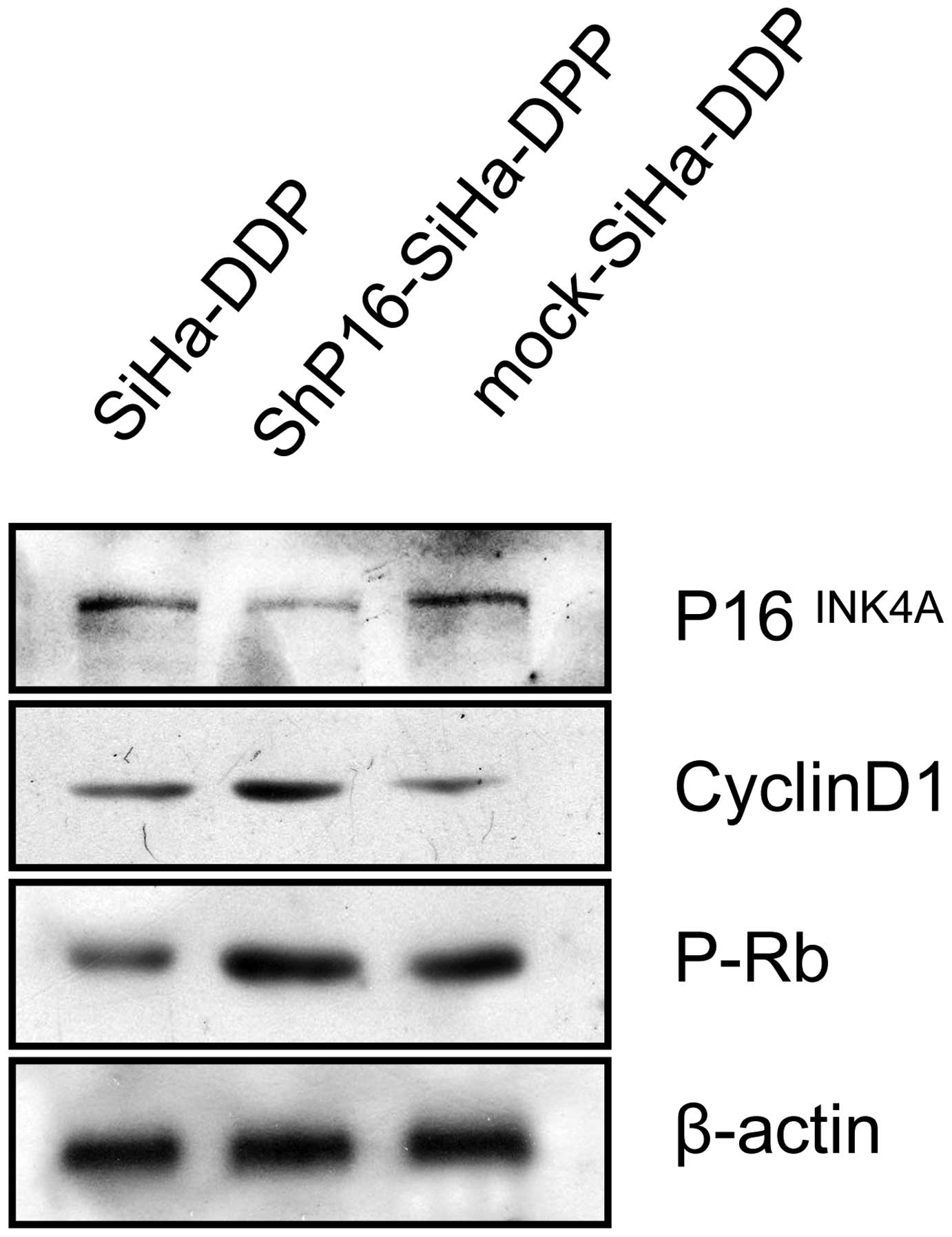
P16INK4A is required for cisplatin resistance in cervical carcinoma SiHa cells
- Authors:
- Yueran Li
- Songshu Xiao
- Liu Dan
- Min Xue
-
View Affiliations
Affiliations: Department of Obstetrics and Gynecology, The Third Xiangya Hospital of Central South University, Changsha, Hunan 410013, P.R. China
- Published online on: December 19, 2014 https://doi.org/10.3892/ol.2014.2814
-
Pages:
1104-1108
-
Copyright: © Li
et al. This
is an open access article distributed under the
terms of Creative
Commons Attribution License.
Metrics:
Total
Views: 0 (Spandidos Publications: | PMC Statistics:
)
Metrics:
Total PDF Downloads: 0 (Spandidos Publications: | PMC Statistics:
)
This article is mentioned in:
Abstract
Cervical cancer is the third most commonly diagnosed cancer worldwide and the fourth leading cause of cancer‑related mortality in females worldwide, accounting for 10‑15% of cancer-related mortalities. Cytological screening and DNA testing for high-risk human papillomavirus (HPV) types have markedly decreased the rates of cervical cancer in developed countries, however, for vulnerable populations without access to health care, cervical cancer remains a considerable problem. Chemotherapeutic agents such as cisplatin (DDP) are considered as first‑line treatment for cervical carcinoma. Although initially patients often exhibit high responsiveness, the majority eventually develop DDP resistance. However, the mechanisms underlying this process remain unclear. Furthermore, patients with metastatic cancer and those exhibiting persistent or recurrent disease after platinum‑based chemoradiotherapy have limited options and thus, non‑platinum combination chemotherapy has been proposed as a strategy to circumvent platinum resistance, however, novel therapeutic strategies are required. In the present study, P16 expression was analyzed by quantitative‑polymerase chain reaction and western blot analysis in SiHa and SiHa-DDP cells and the interaction between P16 and CDK4 was detected via co-immunoprecipitation. In addition, the proliferation and apoptosis rates of P16 knockdown SiHa-DDP cells were measured by MTT assay and Annexin V flow cytometry and the subsequent changes in cyclin D1 and pRb expression were analyzed by western blot analysis. In this study, a high level of P16INK4A expression and its enhanced interaction with cyclin‑dependent kinase‑4 in cervical carcinoma DDP‑resistance cells (SiHa‑DDP) was identified, which was associated with the inactivation of phosphorylated retinoblastoma protein (pRb). Knockdown of P16INK4A significantly induced cellular growth, when compared with the control cells, via the upregulation of pRb, and also promoted apoptosis following treatment with DDP. The results of this study indicated, for the first time, that P16INK4A is required for DDP resistance in cervical carcinoma SiHa cells and, thus, these results may lead to the development of novel strategies for the treatment of chemoresistant cervical carcinoma.
View References
|
1
|
Jemal A, Bray F, Center MM, et al: Global
cancer statistics. CA Cancer J Clin. 61:69–90. 2011. View Article : Google Scholar : PubMed/NCBI
|
|
2
|
Siegel R, Naishadham D and Jemal A: Cancer
statistics, 2013. CA Cancer J Clin. 63:11–30. 2013. View Article : Google Scholar : PubMed/NCBI
|
|
3
|
Kondagunta GV, Sheinfeld J, Mazumdar M, et
al: Relapse-free and overall survival in patients with pathologic
stage II nonseminomatous germ cell cancer treated with etoposide
and cisplatin adjuvant chemotherapy. J Clin Oncol. 22:464–467.
2004. View Article : Google Scholar : PubMed/NCBI
|
|
4
|
Einhorn LH: Role of the urologist in
metastatic testicular cancer. J Clin Oncol. 25:1024–1025. 2007.
View Article : Google Scholar : PubMed/NCBI
|
|
5
|
Siddik ZH: Cisplatin: mode of cytotoxic
action and molecular basis of resistance. Oncogene. 22:7265–7279.
2004. View Article : Google Scholar
|
|
6
|
Shen DW, Pouliot LM, Hall MD and Gottesman
MM: Cisplatin resistance: a cellular self-defense mechanism
resulting from multiple epigenetic and genetic changes. Pharmacol
Rev. 64:706–721. 2012. View Article : Google Scholar : PubMed/NCBI
|
|
7
|
del Moral-Hernández O, López-Urrutia E,
Bonilla-Moreno R, Martínez-Salazar M, Arechaga-Ocampo E, Berumen J
and Villegas-Sepúlveda N: The HPV-16 E7 oncoprotein is expressed
mainly from the unspliced E6/E7 transcript in cervical carcinoma
C33-A cells. Arch Virol. 155:1959–1970. 2010. View Article : Google Scholar : PubMed/NCBI
|
|
8
|
Schmidt M and Fan Z: Protection against
chemotherapy-induced cytotoxicity by cyclin-dependent kinase
inhibitors (CKI) in CKI-responsive cells compared with
CKI-unresponsive cells. Oncogene. 20:6164–6171. 2001. View Article : Google Scholar : PubMed/NCBI
|
|
9
|
Rebbaa A: Targeting senescence pathways to
reverse drug resistance in cancer. Cancer Lett. 219:1–13. 2005.
View Article : Google Scholar : PubMed/NCBI
|
|
10
|
Koster R, di Pietro A, Timmer-Bosscha H,
Gibcus JH, van den Berg A, Suurmeijer AJ and Bischoff R:
Cytoplasmic p21 expression levels determine cisplatin resistance in
human testicular cancer. J Clin Invest. 120:3594–3605. 2010.
View Article : Google Scholar : PubMed/NCBI
|
|
11
|
Mandic R, Schamberger CJ and Müller JF:
Reduced cisplatin sensitivity of head and neck squamous cell
carcinoma cell lines correlates with mutations affecting the
COOH-terminal nuclear localization signal of p53. Clin Cancer Res.
11:6845–6852. 2005. View Article : Google Scholar : PubMed/NCBI
|
|
12
|
Sari Aslani F, Safaei A, Pourjabali M and
Momtahan M: Evaluation of Ki67, p16 and CK17 markers in
differentiating cervical intraepithelial neoplasia and benign
lesions. Iran J Med Sci. 38:15–21. 2013.PubMed/NCBI
|
|
13
|
Vogelstein B and Kinzler KW: Cancer genes
and the pathways they control. Nat Med. 10:789–799. 2004.
View Article : Google Scholar : PubMed/NCBI
|
|
14
|
Nevins JR: The Rb/E2F pathway and cancer.
Hum Mol Genet. 10:699–703. 2001. View Article : Google Scholar : PubMed/NCBI
|
|
15
|
Kaye FJ: RB and cyclin dependent kinase
pathways: defining a distinctionbetween RB and p16 loss in lung
cancer. Oncogene. 21:6908–6914. 2002. View Article : Google Scholar : PubMed/NCBI
|
|
16
|
Giacinti C and Giordano A: RB and cell
cycle progression. Oncogene. 25:5220–5227. 2006. View Article : Google Scholar : PubMed/NCBI
|
|
17
|
Crosby ME and Almasan A: Opposing roles of
E2Fs in cell proliferation and death. Cancer Biol Ther.
3:1208–1211. 2004. View Article : Google Scholar
|
|
18
|
Pei XH and Xiong Y: Biochemical and
cellular mechanisms of mammalian CDK inhibitors: a few unresolved
issues. Oncogene. 24:2787–2795. 2005. View Article : Google Scholar : PubMed/NCBI
|
|
19
|
Chen XL, Wang H, Zhang XM, et al:
Establishment of a cisplatin-resistant human cervical cancer cell
line. Sichuan Da Zue Zue Bao Yixue Ban. 43:151–155. 2012.(In
Chinese).
|
|
20
|
Uchida F, Uzawa K and Kasamatsu A:
Overexpression of CDCA2 in human squamous cell carcinoma:
correlation with prevention of G1 phase arrest and apoptosis. PLoS
One. 8:e563812013. View Article : Google Scholar : PubMed/NCBI
|
|
21
|
Al-Khalaf HH, Colak D and Al-Saif M: p16
(INK4a) positively regulates cyclin D1 and E2F1 through negative
control of AUF1. PLoS One. 6:e211112013. View Article : Google Scholar
|














